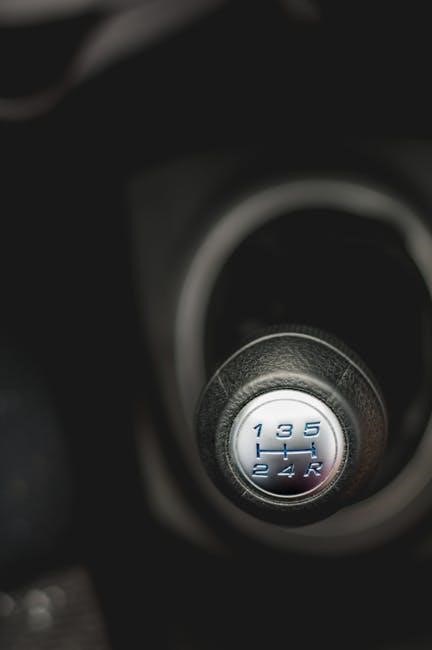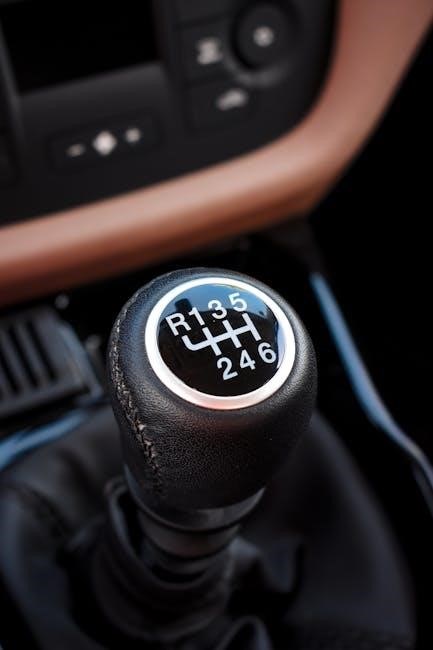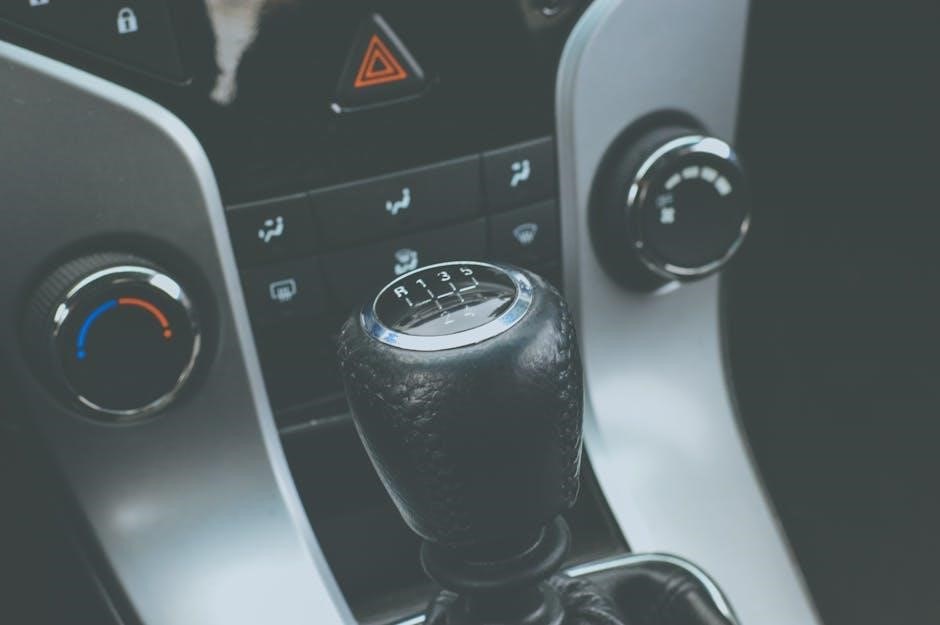
The 5.3 LS engine, known for its durability and power, was never offered with a manual transmission from GM, but enthusiasts have made it possible with adapters.
This swap enables classic vehicles to gain modern V8 power while maintaining driver engagement, offering a cost-effective way to enhance performance and driving experience.
1.1 Overview of the 5.3 LS Engine
The 5.3 LS engine, part of GM’s Gen III small-block V8 family, is a reliable and versatile powerplant known for its durability and performance. Produced from 1999 to 2013, it features a 5.3-liter aluminum-block design, offering a balance of power and efficiency. Initially used in trucks and SUVs, the 5.3L gained popularity for its lightweight construction and impressive power output relative to its size. Its compact size and robust design make it an ideal candidate for engine swaps, especially in classic vehicles. The engine’s simplicity and widespread use have led to extensive aftermarket support, making it a favorite among enthusiasts. Its compatibility with various transmissions, including manual setups, further enhances its appeal for custom builds and performance upgrades.
1.2 Benefits of a Manual Transmission Swap
A manual transmission swap with the 5.3 LS engine offers enhanced driver engagement, improved fuel efficiency, and greater control over performance. The ability to manually shift gears provides a more direct connection to the vehicle, making it ideal for both daily driving and high-performance applications. Additionally, manual transmissions are typically lighter and more durable than their automatic counterparts, reducing weight and potential Points of failure. For classic vehicles, this swap combines modern V8 power with the nostalgic feel of a manual gearbox, creating a unique driving experience. The swap also opens up opportunities for tuning and customization, making it a popular choice among car enthusiasts seeking to optimize both power and drivability.
1.3 Historical Context of LS Engine Swaps
LS engine swaps have become a cornerstone of modern automotive customization, with roots tracing back to the early 2000s. Initially, enthusiasts focused on swapping LS engines into classic cars, leveraging the engine’s compact design and high power output. Manual transmission swaps emerged as a niche within this trend, driven by the desire for greater control and performance. Early adopters often sourced transmissions from Corvette and F-body donors, adapting them to work with the LS platform. Over time, aftermarket support grew, offering bellhousing adapters and custom solutions, making manual swaps more accessible. Today, the LS engine remains a favorite among builders, with manual transmissions becoming an integral part of achieving the perfect balance between power and precision driving.

Choosing the Right Manual Transmission
Selecting the right manual transmission for your 5.3 LS swap involves considering options like the T5, T56, or AR5, each suited for different horsepower and torque levels.
2.1 T5 Transmission: Features and Compatibility
The T5 transmission, known as the “World Class” transmission, is a popular choice for 5.3 LS swaps due to its durability and compatibility with GM engines. Originally used in applications like the ’93 Camaro V6, the T5 is rated for approximately 300 horsepower, making it a suitable option for stock or mildly modified 5.3 LS engines. It is lightweight and compact, ideal for smaller vehicles like the Chevrolet S10. However, its power capacity may be limiting for heavily modified engines. Compatibility requires a custom pilot bushing and a flywheel from a 6.0L 2500HD truck. While it is a cost-effective solution, enthusiasts with higher horsepower goals may need to consider stronger transmissions like the T56 or AR5 for added reliability and performance.
2.2 T56 Transmission: Features and Compatibility
The T56 transmission is a robust 6-speed manual gearbox designed for high-performance applications, making it an excellent choice for 5.3 LS swaps. Originally used in vehicles like the Camaro SS and C5 Corvette, the T56 is well-suited for engines producing higher horsepower and torque. Its durability and smooth shifting capabilities make it a preferred option for enthusiasts seeking a reliable manual transmission. Compatibility with the 5.3 LS engine requires specific adapters, such as a bellhousing adapter and pilot bushing, to ensure proper fitment. While it offers superior performance potential compared to the T5, it also adds weight and complexity to the swap. The T56 is ideal for those aiming to maximize power output and driving engagement in their LS-powered projects.
2.3 AR5 Transmission: Features and Compatibility
The AR5 transmission is a 5-speed manual gearbox that offers a balance between strength and affordability for 5.3 LS engine swaps. Originally used in GM vehicles like the Colorado and Canyon, the AR5 is lightweight and compact, making it a practical choice for smaller projects. It features a robust design with helical gears, providing smooth shifting and moderate torque capacity. Compatibility with the LS engine requires an adapter plate and pilot bushing, similar to other manual transmissions. The AR5 is well-suited for budget-conscious builders who seek a reliable setup without the higher cost of the T56. Its torque rating is sufficient for stock to mildly tuned 5.3 engines, making it a popular alternative in the LS swap community.
2.4 Other Transmission Options and Their Suitability
Beyond the T5, T56, and AR5, other transmissions like the AX15 and NV3500 offer unique benefits. The AX15 is a 5-speed with a strong overdrive gear, making it ideal for highway cruising and fuel efficiency. The NV3500, a 5-speed manual, is known for its durability and higher torque capacity, suitable for heavier vehicles or towing applications. Additionally, the TKX transmission is a modern option rated for 600 lb-ft of torque, offering excellent strength for performance builds. Each of these transmissions requires specific adapters and modifications to mate with the LS engine, but they provide enthusiasts with flexibility based on their performance and budget needs.

Compatibility and Installation Challenges
The 5.3 LS manual swap requires custom adapters, bell housing modifications, and specific pilot bushing solutions for seamless compatibility and smooth installation with a suitable clutch, ensuring optimal performance.
3.1 Bell Housing Adapters for LS Engines
Bell housing adapters are essential for mating the 5.3 LS engine with a manual transmission, as GM never offered this combination from the factory. These adapters ensure proper fitment and alignment between the engine and transmission, addressing the unique bolt pattern of the LS engine block. Popular options include adapters for the T5 and T56 transmissions, which are commonly used in LS swaps. The bell housing must be compatible with both the engine and transmission, requiring precise measurements to avoid any installation issues. Proper installation ensures smooth power delivery and prevents mechanical failure. While aftermarket solutions are readily available, custom fabrication may still be necessary for certain setups. Always verify compatibility before purchasing or installing any adapter kit.
3.2 Flywheel and Clutch System Requirements
The flywheel and clutch system are critical components in a 5.3 LS manual transmission swap. The LS engine requires a specific flywheel design, typically sourced from a 1999-2003 6.0L 2500HD truck, ensuring compatibility with the crankshaft. The clutch system must be upgraded to handle the engine’s torque output, especially if performance enhancements are planned. A high-performance clutch kit, often featuring a heavy-duty pressure plate and disc, is recommended to prevent slippage and premature wear. Proper alignment and installation of these components are essential to avoid vibration and ensure smooth engagement. Additionally, the pilot bushing must be correctly sized and installed to guide the input shaft properly. These components work together to transfer power efficiently from the engine to the transmission, making them vital for a successful swap.
3.3 Pilot Bushing and Custom Fabrication Needs
A pilot bushing is essential for aligning the manual transmission’s input shaft with the LS engine’s crankshaft. Since the 5.3 LS was not originally equipped with a manual transmission, a custom pilot bushing must be fabricated or sourced. This component ensures proper fitment and prevents vibration or misalignment. The pilot bushing is typically machined to precise specifications, requiring high-strength materials like bronze or steel for durability. Additional custom fabrication may be needed for adapter plates or crossmembers to secure the transmission properly. While these modifications can be costly and time-consuming, they are critical for a successful swap. Proper installation ensures smooth operation and prevents premature wear on critical components.
3.4 Wiring Harness and PCM Configuration
When performing a 5.3 LS manual transmission swap, the wiring harness and PCM configuration are critical. The factory wiring harness for an automatic transmission must be modified to accommodate the manual setup, particularly for components like the clutch pedal position sensor. The PCM must be reconfigured to remove dependencies on automatic transmission sensors and ensure proper engine operation. This often requires custom tuning or reflashing the PCM to disable features like torque converter control. Pre-made wiring harnesses from companies like Current Performance Wiring can simplify this process. Proper installation is essential to avoid issues like incorrect gear readings or engine stalling. This step ensures seamless communication between the engine and transmission for optimal performance.

Performance Considerations
The 5.3 LS engine delivers robust power, making it ideal for manual swaps. Upgrading the clutch and transmission ensures optimal performance, especially for high-horsepower applications.
4.1 Horsepower and Torque Ratings of the 5.3 LS
The 5.3 LS engine typically produces 285-315 horsepower and 320-340 lb-ft of torque, depending on its generation and application. These ratings make it a strong candidate for manual transmission swaps, offering a balance of power and efficiency.
The engine’s horsepower and torque output are well-suited for manual transmissions like the T5 or T56, which can handle the power while providing better driver control and engagement compared to automatics.
However, for higher power applications, upgrading the transmission and clutch system is essential to ensure reliability and performance under increased load conditions.
4.2 Transmission Ratings and Their Implications
Manual transmissions like the T5 and T56 have specific horsepower and torque ratings that must align with the 5.3 LS engine’s output. The T5, for instance, is rated for around 300 horsepower, making it borderline suitable for a stock 5.3 LS. Exceeding these ratings can lead to premature wear or failure. Upgrading to a T56 or AR5, with higher torque capacities, is often necessary for modified engines. The choice of transmission directly impacts reliability and performance, emphasizing the need for careful selection based on power goals. Additionally, aftermarket options like the TKX, rated for 600 lb-ft of torque, offer cost-effective solutions for enhanced durability. Balancing transmission ratings with engine output ensures optimal performance and longevity.
4.3 Upgrading the Clutch for Enhanced Performance
Upgrading the clutch is crucial for handling the increased power and torque of the 5.3 LS engine, especially when paired with a manual transmission. A high-performance clutch ensures smooth engagement and prevents slippage under heavy load. Ceramic or multi-disc clutches are popular choices, offering superior durability and heat resistance compared to stock units. Proper installation and alignment are essential to maintain optimal performance and avoid premature wear. Additionally, a lightweight flywheel can improve acceleration and throttle response, making it a worthwhile upgrade for enthusiasts seeking enhanced drivability. Investing in a quality clutch system ensures reliability and maximizes the engine’s potential, particularly for modified or high-performance builds.
4.4 Active Fuel Management and Camshaft Upgrades
Active Fuel Management (AFM) can pose challenges when upgrading the 5.3 LS engine with a manual transmission. AFM disables cylinders under light load, which can cause engine hesitation, especially when paired with a manual trans. Installing an AFM delete kit resolves this issue, allowing the engine to run smoothly and maintain consistent power delivery. Pairing this with a performance camshaft further enhances engine performance, increasing horsepower and torque. Aftermarket camshafts are designed to optimize power across the RPM range, complementing the manual transmission’s responsiveness. These upgrades ensure the engine operates efficiently and delivers the expected performance gains, making them essential for a successful manual transmission swap.

Technical Specifications and Requirements
The 5.3 LS manual swap requires specific adapters for bell housing compatibility, a compatible flywheel for the 6.0L truck setup, VSS installation for PCM function, and consistent bolt patterns for simplified mounting solutions.

5;1 Bolt Patterns and Engine Mounting Solutions
When performing a 5.3 LS manual transmission swap, ensuring proper bolt patterns and engine mounting is crucial. The LS engine features a 4-bolt bellhousing pattern, which differs from the traditional 3-bolt pattern of older Chevrolet engines. This requires specific motor mounts and adapter plates to mate the engine with the transmission and chassis. Compatibility is key, as incorrect mounting can lead to misalignment and potential damage. Many aftermarket companies offer bolt pattern adapters and mounting solutions specifically designed for LS swaps, making the process more accessible. Proper alignment ensures smooth power delivery and prevents long-term mechanical issues, making it a critical step in the swap process.
5.2 VSS (Vehicle Speed Sensor) Installation
Installing a Vehicle Speed Sensor (VSS) is essential for proper operation of the Powertrain Control Module (PCM) in a 5.3 LS manual transmission swap. The VSS provides critical data for speedometer functionality and electronic controls. For manual transmissions, a transmission-mounted VSS or an aftermarket GPS-based sensor can be used. The sensor must be calibrated correctly to ensure accurate readings. Wiring harness modifications may be required to integrate the VSS signal with the PCM. Incorrect installation can lead to issues like inaccurate speedometer readings or PCM errors. Ensuring proper VSS installation is vital for maintaining smooth engine operation and avoiding potential drivability problems. This step is often overlooked but is crucial for a successful swap.

5.3 Fuel Delivery System Upgrades
Upgrading the fuel delivery system is essential for a 5.3 LS manual transmission swap, especially in classic vehicles. The factory fuel system may not support the increased fuel demands of the LS engine. A high-flow fuel pump, larger fuel injectors, and upgraded fuel lines are typically required. The fuel tank may also need modification to ensure proper fuel flow. Additionally, the wiring harness must be configured to support the new fuel system components. Proper fuel delivery ensures reliable engine performance, prevents fuel starvation under load, and supports future engine upgrades. This step is critical for maintaining the engine’s efficiency and power output in a manual transmission setup.
5.4 Special Tools for LS Engine Work
Performing an LS engine swap often requires specialized tools to ensure proper installation and functionality. A crankshaft socket is essential for removing the crankshaft bolt, while an engine mounting tool helps align the engine correctly. Additionally, a wiring harness tool may be needed for re-pinning the PCM. An oil pan socket is useful for oil changes without spills. A bellhousing alignment tool ensures the transmission mates properly with the engine. These tools, often available from LS-specific part manufacturers, simplify the process and prevent potential damage. Investing in the right tools upfront saves time and frustration during the swap. They are indispensable for achieving a seamless and professional-looking installation.

Cost and Budgeting
The 5.3 LS manual transmission swap involves significant costs, including the transmission, engine, adapters, and labor. Budgeting carefully is crucial to avoid financial strain.
6.1 Budgeting for the Transmission and Engine Swap
Budgeting for a 5.3 LS manual transmission swap requires careful planning. The cost of the transmission itself, such as a T5 or AR5, can range from $500 to $2,000, depending on condition and upgrades. Engine acquisition, whether from a salvage yard or a donor vehicle, adds another $1,000 to $3,000. Adapters, clutch systems, and custom fabrication for components like the pilot bushing and bellhousing can add $500 to $1,500. Additionally, a wiring harness and PCM configuration may cost $300 to $1,000. Labor costs, if hiring a professional, can significantly increase the total. Overall, a budget of $3,000 to $7,000 is realistic, depending on the scope and quality of the swap. Sourcing used or refurbished parts can help reduce expenses, but unexpected costs often arise during installation.
6.2 Cost Comparison of Different Transmission Options
When selecting a manual transmission for a 5.3 LS swap, costs vary significantly between models. A used T5 transmission, commonly sourced from GM vehicles, can range from $500 to $1,200, making it the most budget-friendly option. The AR5, offering better durability for higher horsepower, typically costs between $800 to $1,500. For those seeking a more robust option, the T56, known for handling up to 450 horsepower, can range from $1,500 to $3,000. Newer options like the TKX, rated for 600 lb-ft of torque, can cost upwards of $3,000. Prices also vary based on the need for adapters, such as bell housing kits, which add another $300 to $800. These costs highlight the importance of balancing performance goals with budget constraints when choosing a transmission for the swap.
6.3 Hidden Costs and Unexpected Expenses
Beyond the initial cost of the transmission and engine, several hidden expenses can arise during a 5.3 LS manual transmission swap. Custom fabrication, such as a pilot bushing or flywheel, can add $200 to $500. Upgrading the clutch system to handle increased power may cost another $300 to $700. Additionally, a wiring harness and PCM configuration tailored for manual operation can range from $400 to $1,000. Labor costs for specialized mechanics or transmission builders should also be factored in, potentially adding $1,000 to $2,500. Lastly, unexpected expenses like custom drivetrain components or transmission adapters can further inflate the budget. These costs underscore the importance of thorough planning and budgeting to avoid financial surprises during the swap.
6.4 Cost-Effective Solutions and Alternatives
To manage costs during a 5.3 LS manual transmission swap, consider using a T5 or AR5 transmission, which are more affordable and readily available. The T5, sourced from a V6 Camaro, is often priced lower and can handle moderate power levels. Additionally, DIY kits and community-supported solutions can reduce expenses. Many enthusiasts fabricate their own adapters or source used components, cutting costs significantly. For those seeking a balance between performance and affordability, the T5 or AR5 remains a viable option. While high-performance transmissions like the TKX are available, they may not be necessary for stock or mildly modified 5.3 LS engines, making the T5 or AR5 a cost-effective choice for many swap projects.

Community and Forum Insights
Online forums and communities provide valuable insights, sharing DIY solutions and tips for successful 5.3 LS manual transmission swaps, fostering collaboration and innovation among enthusiasts.
7.1 Forum Discussions on Manual Transmission Swaps
Forum discussions on manual transmission swaps for the 5.3 LS engine reveal a vibrant community sharing knowledge and experiences. Enthusiasts often debate transmission choices, with the T5 and T56 being popular options. Many threads highlight the need for adapters and custom fabrication to mate manual transmissions to the LS engine. Some members share success stories of swapping in a T5 from a 1993 Camaro V6, emphasizing its durability for moderate power outputs. Others explore the AR5 as a more robust choice for higher horsepower applications. The community also expresses surprise at the lack of DIY kits, prompting creative solutions and collaboration. These discussions underscore the resourcefulness of LS swap enthusiasts in overcoming challenges and achieving their goals.
7.2 DIY Kits and Community-Supported Solutions
DIY kits for the 5.3 LS manual transmission swap are becoming more accessible, thanks to community-driven innovation. Enthusiasts often fabricate custom adapters for bell housings and pilot bushings, sharing their designs online. Companies like Current Performance Wiring offer pre-made harnesses and motor mounts, simplifying the swap process. Forums showcase members creating their own solutions, such as using flywheels from 6.0L trucks and clutches from LS1-equipped F-bodies. The community collaborates to identify compatible components, ensuring a smoother installation experience. These shared resources empower individuals to tackle the swap with confidence, fostering a culture of self-reliance and collaboration within the LS engine enthusiast community.
7.3 Case Studies from Successful Swaps
Successful 5.3 LS manual transmission swaps often highlight innovative solutions and meticulous planning. A notable example is the 1990 RX-7 swap, where a 5.3 LS engine was paired with a T5 transmission, showcasing the potential for combining modern power with classic chassis. Another case involves an S10 with a 5.3 and T5, demonstrating cost-effective performance gains. These projects illustrate the importance of community insights, as enthusiasts share tips on bellhousing adapters, clutch upgrades, and wiring solutions. Such case studies provide valuable lessons for those embarking on similar swaps, emphasizing the need for careful research and precision to achieve seamless integration and optimal performance from the manual transmission setup.
7.4 Common Mistakes and Lessons Learned
Common mistakes in 5.3 LS manual swaps often stem from overlooking compatibility details. One major error is improper bellhousing adapter installation, leading to alignment issues and potential damage. Another is neglecting to upgrade the clutch system, which can result in premature wear under increased power. Enthusiasts also frequently underestimate the complexity of wiring harness modifications, particularly for the PCM and VSS. Lessons learned emphasize the importance of thorough research, precise measurements, and investing in high-quality components. Additionally, many builders regret not addressing the Active Fuel Management system early on, which can cause engine issues post-swap. Proper planning and attention to these details ensure a smoother, more successful manual transmission swap experience.

Future Trends and Developments
Future trends indicate growing interest in manual transmissions for LS swaps, driven by enthusiast demand for driver engagement and control. Aftermarket support continues to expand, offering improved solutions.
Emerging technologies, such as advanced clutch systems and lightweight components, are expected to enhance performance and accessibility for 5.3 LS manual transmission swaps in coming years.
8.1 Emerging Transmission Technologies
Emerging transmission technologies are revolutionizing the 5.3 LS manual transmission swap. Innovations like the TKX transmission, rated for 600lb-ft of torque, offer robust solutions for high-performance applications.
Lightweight materials and advanced clutch systems are gaining traction, improving both durability and driver experience. Additionally, electronic clutch systems and smart shifting technologies are being explored to optimize power delivery and control.
These advancements not only enhance performance but also make manual transmissions more accessible and reliable for LS engine swaps, catering to the growing demand for driver engagement and precision.
8.2 The Role of Aftermarket Support
The aftermarket plays a crucial role in enabling 5.3 LS manual transmission swaps. Companies now offer pre-made wiring harnesses and motor mounts, simplifying the process for enthusiasts.
Adapters and custom fabrication services are widely available, ensuring compatibility between LS engines and various manual transmissions like the T5 and T56.
This support not only reduces installation challenges but also fosters innovation, allowing builders to push performance boundaries with upgraded clutches and transmission options tailored for higher horsepower.
Such resources have made manual swaps more accessible, turning what was once a niche modification into a viable option for many car enthusiasts.
8.3 Growing Popularity of Manual Transmissions
The popularity of manual transmissions in 5.3 LS swaps has grown significantly, driven by enthusiasts seeking a more engaging driving experience and greater control over power delivery.
Manual transmissions are prized for their ability to maximize the engine’s potential, especially in performance-oriented builds, where driver interaction enhances the overall feel of the vehicle.
The rise of DIY kits and community-supported solutions has made manual swaps more accessible, fostering a culture where enthusiasts can share knowledge and resources.
This trend reflects a broader shift toward preserving the tactile connection between driver and machine, even as automatic transmissions dominate the market.
8.4 The Future of LS Engine Swaps
The future of LS engine swaps continues to evolve, with a strong focus on innovation and accessibility. As enthusiasts push the boundaries, advancements in transmission technology and aftermarket support are expected to make manual swaps even more viable.
The rise of newer transmission options, such as the TKX, offers improved durability and performance, catering to the growing demand for manual control in high-power applications.
Additionally, the integration of modern engine management systems and adaptive fuel delivery solutions will likely streamline the swap process, making it more approachable for DIY builders.
With the LS engine’s proven reliability and the aftermarket’s commitment to development, the future of manual transmission swaps looks bright, ensuring the LS remains a cornerstone of performance builds for years to come.